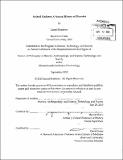| dc.contributor.advisor | Harriet Ritvo. | en_US |
| dc.contributor.author | Braitman, Laurel | en_US |
| dc.contributor.other | Massachusetts Institute of Technology. Program in Science, Technology and Society. | en_US |
| dc.date.accessioned | 2014-04-25T15:49:00Z | |
| dc.date.available | 2014-04-25T15:49:00Z | |
| dc.date.copyright | 2013 | en_US |
| dc.date.issued | 2013 | en_US |
| dc.identifier.uri | http://hdl.handle.net/1721.1/86284 | |
| dc.description | Thesis: Ph. D. in History, Anthropology, and Science, Technology and Society (HASTS), Massachusetts Institute of Technology, Program in Science, Technology and Society, 2013. | en_US |
| dc.description | Cataloged from PDF version of thesis. | en_US |
| dc.description | Includes bibliographical references (pages 255-288). | en_US |
| dc.description.abstract | Beginning in the late 19 th century, changing conceptions of relatedness between people and other animals -- and animals' assumed capacities for, or susceptibilities to, mental or emotional distress-- were influenced by debates over what it meant to be both human and sane in Britain and the United States. Through a historical, partly-ethnographic, investigation of animal insanity in various times and places in the Anglo-American world from the late I 9 th century through the early 21st, I argue that identifying animal madness, insanity, nervous disorders, anxiety disorders, phobias, depression, obsessive compulsivities, suicidal behaviors and more, has not only served as a way of affixing meaning to puzzling animal acts, but has been used to denote borders (or lack thereof) between certain groups of humans and certain groups of animals. As with other divisions, such as those hinging on race, gender, nationality or class, ideas surrounding which humans and which other animals could experience particular forms of insanity have been used to justify certain forms of treatment (or mistreatment), to rationalize needs for confinement or freedom, or to determine what sorts of people and other creatures were deserving of rights and to what degree. I suggest that the history of attempts to identify certain emotional phenomena such as melancholy and suicidal behavior in horses and monkeys, to, more recently, obsessive-compulsivity in parrots and PTSD in military dogs, demonstrates that other animals have acted as mirrors and proxies for disordered Anglo-American minds for more than a century. Drawing upon archival sources, published literature in the fields of ethology, psychology, psychiatry, psychopharmacology, and the veterinary sciences, as well as environmental history, history of medicine and animal studies, combined with interviews and participant observation, I argue that attempts to locate insanity, mental illness, dysfunction and "normalcy" among nonhumans has had wide-ranging effects on diagnostic and therapeutic practices in humans and other animals alike in the United States and Britain. | en_US |
| dc.description.statementofresponsibility | by Laurel Braitman. | en_US |
| dc.format.extent | 288 pages | en_US |
| dc.language.iso | eng | en_US |
| dc.publisher | Massachusetts Institute of Technology | en_US |
| dc.rights | M.I.T. theses are protected by copyright. They may be viewed from this source for any purpose, but reproduction or distribution in any format is prohibited without written permission. See provided URL for inquiries about permission. | en_US |
| dc.rights.uri | http://dspace.mit.edu/handle/1721.1/7582 | en_US |
| dc.subject | Program in Science, Technology and Society. | en_US |
| dc.title | Animal madness : a natural history of disorder | en_US |
| dc.type | Thesis | en_US |
| dc.description.degree | Ph. D. in History, Anthropology, and Science, Technology and Society (HASTS) | en_US |
| dc.contributor.department | Massachusetts Institute of Technology. Program in Science, Technology and Society | |
| dc.identifier.oclc | 876041429 | en_US |
